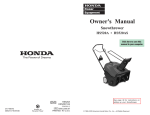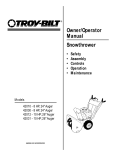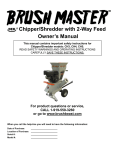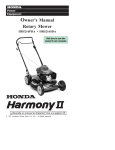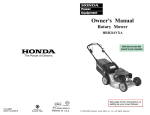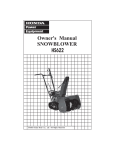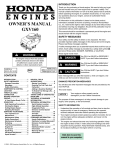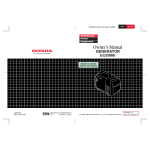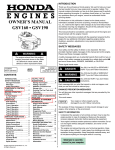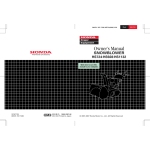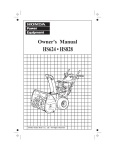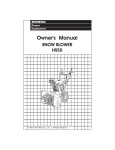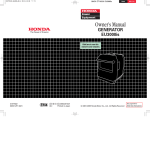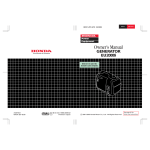Download Honda HS520AS User's Manual
Transcript
® Owner's Manual Snowthrower HS520A • HS520AS ® ® EM 31V10600 00X31-V10-6000 IPC 125000007 PRINTED IN U.S.A. ©1999 American Honda Motor Co., Inc. – All Rights Reserved B WARNING: B The engine exhaust from this product contains chemicals known to the State of California to cause cancer, birth defects, or other reproductive harm. Keep this owner's manual handy, so you can refer to it any time. This owner's manual is considered a permanent part of the snowthrower and should remain with the snowthrower if resold. The information and specifications included in this publication were in effect at the time of approval for printing. Honda Power Equipment Mfg, Inc. reserves the right, however, to discontinue or change specifications or design at any time without notice and without incurring any obligation whatever. HS520.book Page 1 Monday, May 14, 2001 12:36 PM INTRODUCTION Congratulations on your selection of a Honda snowthrower. We are certain you will be pleased with your purchase of one of the finest snowthrowers on the market. We want to help you get the best results from your new snowthrower and to operate it safely. This manual contains the information on how to do that; please read it carefully. As you read this manual, you will find information preceded by a NOTICE symbol. That information is intended to help you avoid damage to your snowthrower, other property, or the environment. We suggest you read the Distributor’s Limited Warranty (page50) and the Emission Control System Warranty (page52) to fully understand its coverage and your responsibilities of ownership. When your snowthrower needs scheduled maintenance, keep in mind that your servicing Honda dealer is specially trained in servicing Honda snowthrowers. Your Honda servicing dealer is dedicated to your satisfaction and will be pleased to answer your questions and concerns. Best Wishes, American Honda Motor Co., Inc. Power Equipment Division 1 HS520.book Page 2 Monday, May 14, 2001 12:36 PM INTRODUCTION A FEW WORDS ABOUT SAFETY Your safety and the safety of others is very important, and using this snowthrower safely is an important responsibility. To help you make informed decisions about safety, we have provided operating procedures and other information on labels and in this manual. This information alerts you to potential hazards that could hurt you or others. Of course, it is not practical or possible to warn you about all the hazards associated with operating or maintaining a snowthrower. You must use your own good judgment. You will find important safety information in a variety of forms including: • Safety Labels — on the snowthrower. • Safety Messages — preceded by a safety alert symbol A and one of three signal words: DANGER, WARNING, or CAUTION. These signal words mean: B DANGER You WILL be KILLED or SERIOUSLY HURT if you don't follow instructions. B WARNING You CAN be KILLED or SERIOUSLY HURT if you don't follow instructions. B CAUTION You CAN be HURT if you don't follow instructions. • Safety Headings — such as IMPORTANT SAFETY INFORMATION. • Safety Section — such as SNOWTHROWER SAFETY. • Instructions — how to use this snowthrower correctly and safely This entire book is filled with important safety information — please read it carefully. 2 HS520.book Page 3 Monday, May 14, 2001 12:36 PM CONTENTS SNOWTHROWER SAFETY...................................................................................... 4 IMPORTANT SAFETY INFORMATION.............................................................. 4 SAFETY LABEL LOCATIONS ............................................................................ 7 CONTROLS & FEATURES ....................................................................................... 8 COMPONENT & CONTROL LOCATIONS ......................................................... 8 CONTROLS ........................................................................................................ 9 BEFORE OPERATION.............................................................................................. 11 ARE YOU READY TO GET STARTED? ............................................................ 11 IS YOUR SNOWTHROWER READY TO GO?................................................... 11 CHECK YOUR WORK AREA ............................................................................. 12 OPERATION .............................................................................................................. 13 SNOWTHROWING PRECAUTIONS .................................................................. 13 STARTING THE ENGINE ................................................................................... 13 STOPPING THE ENGINE................................................................................... 16 CLEARING SNOW.............................................................................................. 17 SNOW-CLEARING TIPS .................................................................................... 17 REMOVING OBSTRUCTIONS ........................................................................... 18 SERVICING YOUR HONDA SNOWTHROWER....................................................... 19 THE IMPORTANCE OF PROPER MAINTENANCE ........................................... 19 MAINTENANCE SAFETY................................................................................... 20 MAINTENANCE SCHEDULE ............................................................................. 21 REFUELING........................................................................................................ 22 FUEL RECOMMENDATIONS............................................................................. 23 ENGINE OIL........................................................................................................ 23 SPARK PLUG SERVICE .................................................................................... 25 AUGER ............................................................................................................... 27 STORAGE ................................................................................................................. 31 STORAGE PREPARATION................................................................................ 31 STORAGE PRECAUTIONS................................................................................ 34 REMOVAL FROM STORAGE ............................................................................ 34 TRANSPORTING ...................................................................................................... 35 BEFORE LOADING ............................................................................................ 35 LOADING AND UNLOADING ............................................................................. 35 TAKING CARE OF UNEXPECTED PROBLEMS ..................................................... 36 ENGINE PROBLEMS ......................................................................................... 36 DRIVE PROBLEMS ............................................................................................ 37 SNOWTHROWER PROBLEMS ......................................................................... 38 SET-UP...................................................................................................................... 39 TECHNICAL & CONSUMER INFORMATION .......................................................... 42 TECHNICAL INFORMATION .............................................................................. 42 EMISSION CONTROL SYSTEM ........................................................................ 45 CONSUMER INFORMATION ............................................................................. 48 INDEX ........................................................................................................................ 54 QUICK REFERENCE INFORMATION............................................... inside back cover 3 HS520.book Page 4 Monday, May 14, 2001 12:36 PM SNOWTHROWER SAFETY IMPORTANT SAFETY INFORMATION Honda snowthrowers are designed to clear snow from driveways and walkways. Other uses can result in injury to the operator or damage to the snowthrower and other property. Most accidents with snowthrowers can be prevented if you follow all instructions in this manual and on the snowthrower. The most common hazards, according to accident statistics, are discussed below, along with the best way to protect yourself and others. Avoid Rotating Auger The snowthrower auger can cause serious cuts and even amputate fingers, hands, toes, or feet. Keep away from the auger whenever the engine is running. If you need to work around the snowthrower to clear snow for any reason, always shut off the engine. If the snow discharge chute becomes clogged, stop the engine and disconnect the spark plug cap. Use a wooden stick to remove the obstruction. Never put your hand into the snow discharge chute while the engine is running; serious personal injury could result. Clear Operation Area The snowthrower can throw rocks and other objects with enough force to cause serious injury. Before operating the snowthrower, carefully inspect the area and remove all stones, sticks, nails, pieces of wire, and other loose objects. Never use the snowthrower to clear snow from a gravel road or driveway, as rocks may be picked up and ejected. They may cause injury to bystanders. 4 HS520.book Page 5 Monday, May 14, 2001 12:36 PM SNOWTHROWER SAFETY Keep Shields in Place Guards and shields are designed to protect you from being hit by thrown objects and to keep you from touching hot engine parts and moving components. For your safety and the safety of others, keep all shields in place when the engine is running. Adjust the snow discharge chute to avoid hitting the operator, bystanders, windows, and other objects with ejected snow. Stay clear of the snow discharge chute while the engine is running. Children and pets must be kept away from the area of operation to avoid injury from flying debris and contact with the snowthrower. Refuel with Care Gasoline is extremely flammable, and gasoline vapor can explode. Allow the engine to cool if the snowthrower has been in operation. Refuel only outdoors in a well-ventilated area with the engine OFF. Never fill the fuel tank beyond the maximum fill mark. Never smoke near gasoline, and keep other flames and sparks away. Always store gasoline in an approved container. Turn Engine Off When Not Operating the Snowthrower If you need to leave the snowthrower for any reason, even just to inspect the area ahead, always turn the engine off. Operation on Slopes To avoid overturning, be careful when changing the direction of the snowthrower while operating it on a slope. Do not use the snowthrower to remove snow from roofs. The snowthrower may overturn on steep slopes if left unattended, causing injury to the operator or bystanders. Operating Conditions Do not use the snowthrower when visibility is poor. Under conditions of poor visibility, there is a greater risk of striking an obstacle or causing injury. Adjust the snow discharge chute to avoid hitting passing bystanders or vehicles. Stay clear of the snow discharge chute while the engine is running. 5 HS520.book Page 6 Monday, May 14, 2001 12:36 PM SNOWTHROWER SAFETY Operating Near Roads Always watch for vehicle traffic when operating the snowthrower near roads and driveways. Never operate the snowthrower on public roads. Operator Responsibility Know how to stop the snowthrower quickly in case of emergency. Understand the use of all snowthrower controls. Never permit anyone to operate the snowthrower without proper instruction. Do not let children operate the snowthrower. If people or pets suddenly appear in front of the snowthrower while it is in operation, immediately release the auger and drive clutch lever to stop the snowthrower and avoid possible injury from the rotating auger. While operating the snowthrower, hold the handle firmly, and walk, don’t run. Wear suitable winter boots that resist slipping. 6 HS520.book Page 7 Monday, May 14, 2001 12:36 PM SNOWTHROWER SAFETY SAFETY LABEL LOCATIONS These labels warn you of potential hazards that can cause serious injury. Read them carefully. If a label comes off or becomes hard to read, contact your Honda snowthrower dealer for a replacement. B DANGER B DANGER B CAUTION HOT MUFFLER CAN BURN YOU. Stay away if engine has been running. KEEP HANDS AND FEET AWAY FROM AUGER WHILE ENGINE IS RUNNING. KEEP HANDS OUT OF DISCHARGE CHUTE WHILE ENGINE IS RUNNING HS520AS B WARNING READ OWNER'S MANUAL BEFORE OPERATING. 7 HS520.book Page 8 Monday, May 14, 2001 12:36 PM CONTROLS & FEATURES COMPONENT & CONTROL LOCATIONS Use the two illustrations on this page to locate and identify the most frequently used controls. CHUTE GUIDE HANDLE HANDLEBAR AUGER CLUTCH LEVER SPARK PLUG COVER FUEL CAP CHOKE KNOB FUEL VALVE STARTER GRIP OIL FILLER CAP ENGINE OIL DRAIN PLUG HS520AS ENGINE SWITCH STARTER BUTTON 8 HS520.book Page 9 Monday, May 14, 2001 12:36 PM CONTROLS & FEATURES CONTROLS Fuel Valve OFF The fuel valve opens and closes the fuel line leading from the fuel tank to the carburetor. Make sure that the fuel valve is positioned exactly at either the ON or OFF position. When the snowthrower is not in use, always leave the fuel valve in the OFF position to reduce the possibility of fuel leakage. ON Engine Switch ON The engine switch controls the ignition system. The HS520A has an OFF-ON-OFF switch, while the HS520AS has a key that controls an OFF-ON switch. OFF — Stops the engine. ON — Running position, and for starting with the recoil or electric starter (HS502AS). OFF OFF ON HS520A ON HS520AS Starter Button (HS520AS) The starter button is used to operate the electric starter when a household extension cord is plugged into the starter box. STARTER BUTTON STARTER BOX Starter Grip Pull this grip to start the engine. See page 13 for starting procedures. 9 HS520.book Page 10 Monday, May 14, 2001 12:36 PM CONTROLS & FEATURES Choke Knob The choke knob is used to open or close the choke. CLOSED is used when the engine is cold. CLOSED OPEN The OPEN position provides the correct fuel mixture for operation after the engine has warmed up, and for starting a warm engine. Chute Guide Handle Use this control to guide the snow discharge angle and direction. LOW AND NEAR LEFT HIGH AND FAR RIGHT Auger Clutch Lever ENGAGE When this lever is engaged, the snowthrower auger paddles begin to spin and the snowthrower will move forward. Do not engage the auger clutch lever on cleared ground or the snowthrower will move forward suddenly. 10 RELEASE HS520.book Page 11 Monday, May 14, 2001 12:36 PM BEFORE OPERATION ARE YOU READY TO GET STARTED? Your safety is your responsibility. A little time spent in preparation will significantly reduce your risk of injury. Knowledge Read and understand this manual. Know what the controls do and how to operate them. Familiarize yourself with the snowthrower and its operation before you begin using it. Know how to quickly shut off the snowthrower in case of an emergency. IS YOUR SNOWTHROWER READY TO GO? For your safety, and to maximize the service life of your equipment, it is very important to take a few moments before you operate the snowthrower to check its condition. Be sure to take care of any problem you find, or have your servicing dealer correct it, before you operate the snowthrower. B WARNING Improperly maintaining this snowthrower, or failing to correct a problem before operation, could cause a malfunction in which you could be seriously injured. Always perform a preoperation inspection before each operation, and correct any problem. Before beginning your preoperation checks, be sure the snowthrower is on a level surface and the engine switch is in the OFF position. 11 HS520.book Page 12 Monday, May 14, 2001 12:36 PM BEFORE OPERATION Check the General Condition of the Snowthrower: • • • • • • Look around and underneath the snowthrower for signs of oil or gasoline leaks. Check the auger housing and the discharge chute for accumulation of packed snow or ice. Clean the auger housing and discharge chute before starting the snowthrower. Look for signs of damage. Check each control for proper operation. Check the scraper bar for wear. Replace it if necessary (page29). Check that all nuts, bolts, screws are tightened. Check the Engine • • Check the oil level (page23). Check the fuel level (page22). Starting with a full tank will help to eliminate or reduce operating interruptions for refueling. CHECK YOUR WORK AREA For your safety and the safety of others, always inspect the area before operating the snowthrower. Objects Anything which can be picked up by the auger and thrown is a potential hazard to you and others. Look for things like stones, sticks, nails, and wire, and remove them from the work area. People and Pets People and animals near the work area can move into your snowthrowers path or into a position where they could be struck by thrown objects. Clear the area of people, especially children and pets. Their safety is your responsibility. Work Area Check the condition of the snow. Adjust your snowthrower ground speed and snowblowing swath accordingly. Check the scraper bar for proper adjustment. Check the scraper bar for the correct auger ground clearance (page30). 12 HS520.book Page 13 Monday, May 14, 2001 12:36 PM OPERATION SNOWTHROWING PRECAUTIONS Before operating the snowthrower for the first time, please review both the SNOWTHROWER SAFETY chapter (page 4) and the BEFORE OPERATION chapter (page11). Even if you have operated other snowthrowers, take time to become familiar with how this snowthrower works, and practice in a safe area until you build up your skills. Never tamper with, or alter any of the controls or safety devices on the snowthrower. For your safety, avoid starting or operating the engine in an enclosed area such as a garage. Your snowthrower’s exhaust contains poisonous carbon monoxide gas which can collect rapidly in an enclosed area and cause illness or death. B WARNING Carbon monoxide gas is toxic. Breathing it can cause unconsciousness and even kill you. Avoid any enclosed areas or activities that expose you to carbon monoxide. STARTING THE ENGINE 1. Turn the fuel valve to the ON position. ON 13 HS520.book Page 14 Monday, May 14, 2001 12:36 PM OPERATION 2. If the engine is cold, pull the choke knob out to the CLOSED position. CLOSED 3. Start the engine. Electric Start (AS model only): a. Connect an extension cord to the starter box first, then to a 120 volt ac outlet. 120 VAC OUTLET 3-CONDUCTOR EXTENSION CORD STARTER BOX PLUG To minimize the possibility of potentially dangerous electrical shock, always use a 3-conductor power cord with a power rating of no less than 15 amps. Also, be sure that the outlet you are using is properly grounded. Do not connect and disconnect the power cord with wet hands. Be sure to hold the plug when disconnecting the power cord from the electrical outlet or starter box. Do not disconnect by pulling on the power cord. b. Turn the engine switch to the ON position. 14 ON HS520.book Page 15 Monday, May 14, 2001 12:36 PM OPERATION c. Push the starter button until the engine starts. After the engine starts, disconnect the power cord from the electrical outlet, and then from the switch box. NOTICE Do not operate the starter for more than 15 seconds. If the engine fails to start, release the button and allow the starter to cool for 5 minutes before operating it again. Manual (Pull) Starting a. Turn the engine switch to the ON position. ON ON HS520A HS520AS b. Pull the starter grip slowly until you feel resistance, then pull briskly. c. Return the starter grip gently. NOTICE Do not allow the starter grip to snap back against the starter bracket. Return it gently to prevent damage. NOTICE Do not pull the starter grip while the engine is running. The starter could be damaged. 15 HS520.book Page 16 Monday, May 14, 2001 12:36 PM OPERATION 4. Let the engine warm up for several minutes. If the choke knob has been pulled to the CLOSED position to start the engine, gradually push it to the OPEN position as the engine warms up. STOPPING THE ENGINE To stop the engine in an emergency, turn the engine switch to the OFF position. Under normal conditions, use the following procedure. 1. Release the auger clutch lever. The auger will stop operation. RELEASE 2. Turn the engine switch to the OFF position. OFF HS520A OFF OFF 3. Turn the fuel valve to the OFF position. 16 HS520AS OFF HS520.book Page 17 Monday, May 14, 2001 12:36 PM OPERATION CLEARING SNOW 1. Press down on the handlebar to raise the front of the snowthrower slightly. Roll the snowthrower over to the snow area. 2. Use the chute guide handle (page10) to adjust the direction for the discharged snow to travel. ENGAGE AUGER 3. Engage the auger clutch lever. The auger will begin to spin. 4. Tilt the snowthrower forward slightly with handlebar to engage the auger into the snow. The auger will then pull the snowthrower forward and discharge the snow. TILT FORWARD SLIGHTLY 5. To stop, lower the handlebar slightly, then release the auger clutch lever. SNOW-CLEARING TIPS For best efficiency, clear snow before it melts, refreezes and hardens. Do not reduce engine speed while clearing snow. Operating tips for clearing hard or deep snow: • Clear snow with a back and forth motion. Release the auger clutch lever, then press down on the handlebar to raise the auger housing when pulling the snowblower backwards. • Clear a narrower swath. Make several passes with the auger overlapping the cleared areas. 17 HS520.book Page 18 Monday, May 14, 2001 12:36 PM OPERATION • If the snow is deeper than the height of the auger, remove it in several layers, as shown here. REMOVING OBSTRUCTIONS If the discharge chute or snow blowing mechanism becomes restricted, review clearing snow information (page12) to reduce the possibility of reoccurring obstructions. 1. Before removing the obstruction, be sure to stop the engine, and make sure that all rotating parts have come to a complete stop. Remove the spark plug cap from the spark plug (page25). 2. Use a wooden stick to clear the obstruction. 18 HS520.book Page 19 Monday, May 14, 2001 12:36 PM SERVICING YOUR HONDA SNOWTHROWER THE IMPORTANCE OF PROPER MAINTENANCE Proper maintenance is essential for safe, economical, and trouble-free operation. It will also help reduce air pollution. To help you properly care for your snowthrower, the following pages include a maintenance schedule, routine inspection procedures, and simple maintenance procedures using basic hand tools. Other service tasks that are more difficult, or require special tools, are best handled by professionals and are normally performed by a Honda technician or other qualified mechanic. The maintenance schedule applies to normal operating conditions. If you operate your snowthrower under unusual conditions, consult your servicing dealer for recommendations applicable to your individual needs and use. Remember that your servicing dealer knows your snowthrower best and is fully equipped to maintain and repair it. B WARNING Improper maintenance, or failure to correct a problem before operation, can cause a malfunction in which you can be seriously hurt or killed. Always follow the inspection and maintenance recommendations and schedules in this owner’s manual. To ensure the best quality and reliability, use only new, genuine Honda parts or their equivalents for repair and replacement. Maintenance, replacement, or repair of the emission control devices and systems may be performed by any engine repair establishment or individual, using parts that are “certified” to EPA standards. 19 HS520.book Page 20 Monday, May 14, 2001 12:36 PM SERVICING YOUR HONDA SNOWTHROWER MAINTENANCE SAFETY Some of the most important safety precautions follow. However, we cannot warn you of every conceivable hazard that can arise in performing maintenance. Only you can decide whether or not you should perform a given task. B WARNING Failure to properly follow maintenance instructions and precautions can cause you to be seriously hurt or killed. Always follow the procedures and precautions in the owner’s manual. Safety Precautions • Make sure the engine is off before you begin any maintenance or repairs. This will eliminate several potential hazards: — Carbon monoxide poisoning from engine exhaust. Be sure there is adequate ventilation whenever you operate the engine. — Burns from hot parts. Let the engine and exhaust system cool before touching. — Injury from moving parts. Do not run the engine unless instructed to do so. • Read the instructions before you begin, and make sure you have the tools and skills required. • To reduce the possibility of fire or explosion, be careful when working around gasoline. Use only a nonflammable solvent, not gasoline, to clean parts. Keep cigarettes, sparks, and flames away from all fuel-related parts. 20 HS520.book Page 21 Monday, May 14, 2001 12:36 PM SERVICING YOUR HONDA SNOWTHROWER MAINTENANCE SCHEDULE Item • Engine oil • Spark plug Scraper bar Moving parts • Fuel tank and carburetor Auger clutch lever freeplay • Engine speed Action check change check & clean replace checkreadjust apply oil drain • Fuel filter checkreadjust check & adjust check • Fuel line replace • Valve check & adjust clean clearance Combustion chamber EACH USE FIRST Every Year 25 HRS BEFORE BEFORE OPERATION OPERATION STORAGE EVERY 150 HRS O 23 O O (1) O (1) 24 O O O Page O (1) 25 29 O 33 O 32 O 27 O(2) O(2) Every 2 years (2) O(2) After every 250 hours (2) Shop manual Shop manual Shop manual Shop manual — • Emission related items (1) Service every 10 hours or daily when used under extremely harsh conditions, or if used commercially. (2) These items should only be serviced by an authorized Honda servicing snowthrower dealer unless you are mechanically proficient and have the proper tools. 21 HS520.book Page 22 Monday, May 14, 2001 12:36 PM SERVICING YOUR HONDA SNOWTHROWER REFUELING FUEL TANK CAPACITY: 0.3 US gallon (1.3 liters) Stop the engine, remove the cap and check the fuel level. Refill the tank if the fuel level is low. Do not fill above the base of the filler neck. MAXIMUM FILL POINT B WARNING Gasoline is highly flammable and explosive. You can be burned or seriously injured when handling fuel. • Stop the engine and keep heat, sparks, and flame away. • Handle fuel only outdoors. • Wipe up spills immediately. Refuel in a well-ventilated area before starting the engine. If the engine has been running, allow it to cool. Refuel carefully to avoid spilling fuel. Do not fill the fuel tank above the fuel strainer shoulder. After refueling, tighten the fuel tank cap securely. Never refuel the engine inside a building where gasoline fumes may reach flames or sparks. Keep gasoline away from appliance pilot lights, barbecues, electric appliances, power tools, etc. Spilled fuel is not only a fire hazard, it causes environmental damage. Wipe up spills immediately. 22 HS520.book Page 23 Monday, May 14, 2001 12:36 PM SERVICING YOUR HONDA SNOWTHROWER FUEL RECOMMENDATIONS Use unleaded gasoline with a pump octane rating of 86 or higher. These engines are certified to operate on unleaded gasoline. Unleaded gasoline produces fewer engine and spark plug deposits and extends exhaust system life. Never use stale or contaminated gasoline or an oil/gasoline mixture. Avoid getting dirt or water in the fuel tank. Occasionally you may hear a light “spark knock” or “pinging” (metallic rapping noise) while operating under heavy loads. This is no cause for concern. If spark knock or pinging occurs at a steady engine speed, under normal load, change brands of gasoline. If spark knock or pinging persists, see an authorized Honda servicing dealer. NOTICE Running the engine with persistent spark knock or pinging can cause engine damage. Running the engine with persistent spark knock or pinging is misuse, and the Distributor's Limited Warranty does not cover parts damaged by misuse. ENGINE OIL Oil Level Check Check the engine oil level with the snowthrower stopped and in a level position. 1. Remove the oil filler cap/dipstick and wipe it clean. 2. Insert and remove the dipstick without screwing it into the filler neck. 3. If the level is low, fill to the edge of the oil filler hole with the recommended oil (page25). UPPER LIMIT 4. Reinstall the oil filler cap/dipstick. NOTICE Running the engine with a low oil level can cause engine damage. 23 HS520.book Page 24 Monday, May 14, 2001 12:36 PM SERVICING YOUR HONDA SNOWTHROWER Engine Oil Change Drain the oil while the engine is still warm to assure rapid and complete draining. DRAIN PLUG & WASHER 1. Place the snowthrower on a level surface. 2. Place a suitable container below the drain bolt to catch the used oil, then remove the oil filler cap/dipstick and the drain plug. 3. Allow the used oil to drain completely, then reinstall the drain plug, and tighten it securely. NOTICE Improper disposal of engine oil can be harmful to the environment. If you change your own oil, please dispose of used motor oil properly. Put it in a sealed container, and take it to a recycling center. Do not throw it in the trash, pour it on the ground, or down a drain. 4. With the engine in a level position, fill to the outer edge of the oil filler hole with the recommended oil (page25). OIL CAPACITY: 0.63 US quart (20.3 fl oz, 0.6 liter) NOTICE Running the engine with a low oil level can cause engine damage. 5. Screw in the oil filler cap/dipstick securely. 24 HS520.book Page 25 Monday, May 14, 2001 12:36 PM SERVICING YOUR HONDA SNOWTHROWER Engine Oil Recommendations SAE 5W-30 G Y IN G II R VI C E I SE SJ ER EN SAE 5W-30 is recommended for general use. Other viscosities shown in the chart may be used when the average temperature in your area is within the indicated range. The SAE oil viscosity and service classification are on the API label on the oil container. Honda recommends that you use API SERVICE category SJ oil with the “starburst” certification mark displayed on the container. AP Oil is a major factor affecting performance and service life. Use a high quality 4-stroke automotive detergent oil. V CONS ER 5W-30 0W-30 SPARK PLUG SERVICE To ensure proper engine operation, the spark plug must be properly gapped and free of deposits. 1. Open the spark plug access panel, then remove the spark plug cap. Use a commercially available spark plug wrench or socket to remove the spark plug. 2. Inspect the spark plug. Replace it if the electrodes are worn or if the insulator is cracked or chipped. If it is to be reused, clean the electrode and insulator with a wire brush. NOTICE Use only the recommended spark plugs or equivalent. Spark plugs which have an improper heat range may cause engine damage. 25 HS520.book Page 26 Monday, May 14, 2001 12:36 PM SERVICING YOUR HONDA SNOWTHROWER A replacement spark plug may be purchased from a servicing Honda snowthrower dealer. See page 49 for a part number list. SPARK PLUG: BPR5ES (NGK) or W16EPR-U (DENSO) 3. Measure the plug gap with a feeler gauge. Correct as necessary by 0.028 ~ 0.031 inch bending the side electrode. (0.70 ~ 0.80 mm) PLUG GAP: 0.028 - 0.031 inch (0.70 - 0.80 mm) 4. Make sure that the spark plug washer is in good condition, and thread the spark plug in by hand to prevent crossthreading. 5. After the spark plug is seated, tighten with a spark plug wrench to compress the washer. If installing a new spark plug, tighten 1/2 turn after the spark plug seats to compress the washer. If reinstalling a used spark plug, tighten 1/8 to 1/4 turn after the spark plug seats. NOTICE The spark plug must be securely tightened. An improperly tightened spark plug can become hot and may damage the engine. 6. Connect the spark plug cap and close the spark plug access panel. 26 HS520.book Page 27 Monday, May 14, 2001 12:36 PM SERVICING YOUR HONDA SNOWTHROWER AUGER Clutch Lever Inspection 7-1/2 ~ 8 inches (190 ~ 205 mm) 1. Move the clutch lever until you feel resistance from the cable. Measure the distance as shown. CLUTCH LEVER DISTANCE: 7-1/2 ~ 8 inches (190 ~ 205 mm) Adjustment SPRING COVER 1. Pull the spring cover up to expose the tension spring. Change the position of either the cable or spring on the metal plate so the clutch lever distance is correct. Moving the spring makes a 1/4 inch (10 mm) change, while moving the cable makes a 1/8 inch (6 mm) change. 2. Slide the cover back over the spring. 1/4 inch (10 mm) 1/8 inch (6 mm) 27 HS520.book Page 28 Monday, May 14, 2001 12:36 PM SERVICING YOUR HONDA SNOWTHROWER Belt Tension Inspection & Adjustement 1. Pull the spring cover up to expose the belt tension spring. Have a helper engage the auger clutch lever. Measure the length of the exposed coils as shown. 2. Remove the z-bend fitting from the upper hole on the auger clutch lever, and install it into the lower hole. Recheck the spring length. If it is still out of specification, check the auger clutch lever (P. 27). Auger Paddle Inspection 3 inches (78 mm) LOWER HOLE Z-BEND The paddles are thick, rubber parts bolted to the edges of the auger. The paddle are subject to wear, and should be inspected and replaced if worn beyond the service limit. 1. Park the snowblower on a flat, level surface. Disconnect the spark plug cap. Tilt the snowblower back enough to raise the auger housing. 2. Inspect the paddles on the auger and make sure they are in good condition and securely attached. 5/8 inch (15 mm) 3. Measure the distance between the edge of the rubber paddle to the edge of the metal auger support. AUGER PADDLE SERVICE LIMIT: 5/8 inch (15 mm) Auger paddle replacement should only be done by a servicing Honda snowthrower dealer. If the paddles are worn out, the scraper bar may also need replacement (page29). 28 HS520.book Page 29 Monday, May 14, 2001 12:36 PM SERVICING YOUR HONDA SNOWTHROWER Scraper Bar The scraper bar wears with normal use and must be replaced when it reaches its service limit. The scraper bar thickness and adjustment determine the clearance between the rubber paddles and the ground. Inspection 1. Turn the engine switch to the OFF position, and disconnect the spark plug cap, so the engine cannot be accidentally started. 2. Examine the scraper bar and verify it contacts the ground evenly. If not, adjust it. 3. Tilt the snowthrower back and measure the thickness of the scraper bar. Replace the scraper bar if it less than 1/16 inch (2 mm) thick. 1/16 inch (2 mm) SCRAPER BAR THICKNESS SERVICE LIMIT: 1/16 inch (2 mm) SCRAPER BAR 29 HS520.book Page 30 Monday, May 14, 2001 12:36 PM SERVICING YOUR HONDA SNOWTHROWER A replacement scraper bar may be purchased from a servicing Honda snowthrower dealer. See page49 for a part number list. 4. Measure the distance between the ground and lowest point on the rubber paddle on the auger. 1/16 ~ 1/8 inch (1 ~ 3mm) PADDLE GROUND CLEARANCE: 1/16 ~ 1/8 inch (1 ~ 3 mm) Adjustment/Replacement 1. Loosen (don’t remove) the three hex nuts on the scraper bar. CARRIAGE BOLT (3) 2. Move the scraper bar down slightly. Tighten the self-locking nuts and recheck the clearance. Repeat the procedure as needed to get the necessary clearance. If you can’t get the spacing within specification, replace the scraper bar. HEX NUT (3) SCRAPER BAR Adjust position as required. CARRIAGE BOLT (3) SCRAPER BAR FLAT WASHER (3) HEX NUT (3) A new scraper bar may be purchased from a servicing Honda snowblower dealer. See page49 for scraper bar and hardware part numbers. 30 HS520.book Page 31 Monday, May 14, 2001 12:36 PM STORAGE STORAGE PREPARATION Proper storage preparation is essential for keeping your snowthrower troublefree and looking good. The following steps will help to keep rust and corrosion from impairing your snowthrower’s function and appearance, and will make the engine easier to start when you use the snowthrower again. Cleaning 1. Rinse the auger housing and wheels with a garden hose. Wipe the rest of the snowthrower with a moist rag. 2. After the snowthrower has dried, touch up any damaged paint. Fuel Gasoline will oxidize and deteriorate in storage. Old gasoline will cause hard starting, and it leaves gum deposits that clog the fuel system. If the gasoline in your engine deteriorates during storage, you may need to have the carburetor and other fuel system components serviced or replaced. The length of time that gasoline can be left in your fuel tank and carburetor without causing functional problems will vary with such factors as gasoline blend, your storage temperatures, and whether the fuel tank is partially or completely filled. The air in a partially filled fuel tank promotes fuel deterioration. Very warm storage/ temperatures accelerate fuel deterioration. Fuel deterioration problems may occur within a few months, or even less if the gasoline was not fresh when you filled the fuel tank. The Distributor's Limited Warranty does not cover fuel system damage or engine performance problems resulting from neglected storage preparation. You can extend fuel storage life by adding a fuel stabilizer that is formulated for that purpose, or you can avoid fuel deterioration problems by draining the fuel tank and carburetor. 31 HS520.book Page 32 Monday, May 14, 2001 12:36 PM STORAGE Adding a Fuel Stabilizer to Extend Fuel Storage Life When adding a fuel stabilizer, fill the fuel tank with fresh gasoline. If only partially filled, air in the tank will promote fuel deterioration during storage. If you keep a container of gasoline for refueling, be sure that it contains only fresh gasoline. Add fuel stabilizer following the manufacturer's instructions. After adding a fuel stabilizer, run the engine outdoors for 10 minutes to be sure that treated gasoline has replaced the untreated gasoline in the carburetor. Stop the engine, and move the fuel valve to the OFF position. Draining the Fuel Tank and Carburetor 1. Place an approved gasoline container below the carburetor drain tube, and use a funnel to avoid spilling fuel. Turn the fuel valve to the ON position. DRAIN SCREW 2. Insert a long, flat-tip screwdriver into the access hole on the left side. Locate the carburetor drain screw near carburetor bowl. Loosen (don’t remove) the drain screw until the fuel starts to drain. Drain until the fuel tank is empty, then tighten the drain screw. B WARNING Gasoline is highly flammable and explosive. You can be burned or seriously injured when handling fuel. • Keep heat, sparks, and flame away. • Handle fuel only outdoors. • Wipe up spills immediately. 32 HS520.book Page 33 Monday, May 14, 2001 12:36 PM STORAGE Engine Oil 1. Change the engine oil (page24). 2. Remove the spark plug (page25). 3. Pour a tablespoon (5 ~ 10 cc) of clean engine oil into the cylinder. 4. Pull the starter rope slowly several times to distribute the oil. 5. Reinstall the spark plug. 6. Pull the starter grip until resistance is felt. This will close the valves and protect the engine from internal corrosion. Lubrication Apply a few drops of oil and a small amount of grease to the following parts for lubrication and rust prevention. CHUTE HINGE PIN G H CHUTE TENSION BOLTS G AUGER CLUTCH LEVER AUGER SHAFT BEARINGS G 33 HS520.book Page 34 Monday, May 14, 2001 12:36 PM STORAGE STORAGE PRECAUTIONS If your snowthrower will be stored with gasoline in the fuel tank and carburetor, it is important to reduce the hazard of gasoline vapor ignition. Select a well-ventilated storage area away from any appliance that operates with a flame, such as a furnace, water heater, or clothes dryer. Also avoid any area with a spark-producing electric motor, or where power tools are operated. If possible, avoid storage areas with high humidity, because it promotes rust and corrosion. Unless all fuel has been drained from the fuel tank, leave the fuel valve in the OFF position to reduce the possibility of fuel leakage. Place the snowthrower on a level surface. Tilting can cause fuel or oil leakage. With the engine and exhaust system cool, cover the snowthrower to keep out dust. A hot engine and exhaust system can ignite or melt some materials. Do not use sheet plastic as a dust cover. A nonporous cover will trap moisture around the engine, promoting rust and corrosion. REMOVAL FROM STORAGE Check your snowthrower as described in the BEFORE OPERATION chapter (page11). If the fuel was drained during storage preparation, fill the tank with fresh gasoline. If you keep a container of gasoline for refueling, be sure that it contains only fresh gasoline. Gasoline oxidizes and deteriorates over time, causing hard starting. If the cylinder was coated with oil during storage preparation, the engine may smoke briefly at startup. This is normal. 34 HS520.book Page 35 Monday, May 14, 2001 12:36 PM TRANSPORTING BEFORE LOADING If the engine has been running, allow it to cool for at least 15 minutes before loading the snowthrower on the transport vehicle. A hot engine and exhaust system can burn you and can ignite some materials. Turn the fuel valve to OFF. This will prevent carburetor flooding and reduce the possibility of fuel leakage. Avoid removing any parts from the snowblower before transport, unless you are mechanically proficient, have the right tools, and follow the procedures in the HS520 Shop Manual (see page 4-95). LOADING AND UNLOADING If a suitable loading ramp is not available, two people should lift the snowthrower on and off the transport vehicle while holding the snowthrower level. Position the snowthrower so both wheels and the auger box are on the bed of the transport vehicle. Tie the snowthrower down with rope or straps, and block the wheels. Keep the tie-down rope or straps away from the auger drive clutch lever and cable. 35 HS520.book Page 36 Monday, May 14, 2001 12:36 PM TAKING CARE OF UNEXPECTED PROBLEMS ENGINE PROBLEMS Electric starter does not operate Possible cause Correction Check electrical outlet. No electric current from outlet. Try known good electrical outlet. Start engine by using the recoil starter. Check power cord. Defective power cord. Try another power cord. Start engine with the recoil starter. Starter operates, but engine will not start Possible cause Correction Check fuel delivery to engine. Fuel valve is OFF. Turn fuel valve to ON (page13). Check fuel condition. Stale or old fuel. Be sure tank has fresh fuel. Drain carburetor (page32). Check for spark. Spark plug cap off. Make sure cap is connected. Verify that spark plugs are free of deposits, and have proper gap (page25). Improper gap or deposits in the spark plug(s) gap. 36 HS520.book Page 37 Monday, May 14, 2001 12:36 PM TAKING CARE OF UNEXPECTED PROBLEMS Engine has low power Possible cause Correction Check ground speed. Fast ground speed when blowing wet, deep snow puts excessive load on engine. Operate at slower ground speed. Snowthrowing swath too wide for snow conditions. Wet, deep snow can put an excessive load on engine. Reduce snowthrowing swath. Check auger housing. Discharge chute restricted. Clear discharge chute obstructions (page18). Check spark plug. Spark plug cap not secure. Make sure spark plug cap is securely connected. Verify the spark plug is free of deposits and has proper gap. Improper electrode gap or deposits on gap. Check choke position. Choke in wrong position. Make sure the choke is in the OPEN position (page10). Check fuel condition. Stale or old fuel. Be sure tank has fresh fuel. Drain carburetor (page32). DRIVE PROBLEMS Engine runs, but snowthrower doesn't operate Possible cause Correction Check auger paddle Auger paddles worn out Replace auger paddles Check auger clutch lever for position. Lever is not engaged. Engage auger clutch lever by pulling it toward handlebar Check drive clutch lever. Drive clutch lever freeplay is excessive Adjust freeplay (page27) Auger not engaging. Drive belt worn, broken or not on pulleys. See servicing Honda snowthrower dealer. 37 HS520.book Page 38 Monday, May 14, 2001 12:36 PM TAKING CARE OF UNEXPECTED PROBLEMS SNOWTHROWER PROBLEMS Won't blow snow Possible cause Correction Check auger housing. Discharge chute restricted. Foreign object stopping auger from rotating. Clear discharge chute of obstructions (page18). Remove foreign object. Auger not engaging. Belt worn, not on pulleys or not properly installed. See servicing Honda snowthrower dealer. Snow not discharging properly Possible cause Correction Auger not engaging. Belt worn, not on pulleys or not properly installed. See servicing Honda snowthrower dealer. Check snow conditions. Wet, deep snow is difficult to blow. Reduce snowblowing swath (page17). Check ground speed. snowthrower is moving too fast for snow conditions. Reduce ground speed (page17). Engine stalls when auger clutch lever is engaged Possible cause Correction Check auger housing. Discharge chute restricted. Foreign object stopping auger from rotating. Auger frozen by ice. Clear discharge chute or auger housing of obstruction (page18). 38 HS520.book Page 39 Monday, May 14, 2001 12:36 PM SET-UP Tools Required • 12 mm wrench, 10 mm wrench, and a Phillips-head screwdriver Unpacking 1. Remove all the cardboard. Inspect the loose parts. Missing parts may be obtained from a servicing Honda snowthrower dealer. Qty. Description Part number 4 Curved head bolt 8 x 40 mm 90109-VA4-000 4 Flange nut, 8 mm 94050-08000 4 Curved washer, 9 mm 90501-898-000 3 Phillips head shoulder screw 6 x 12 mm 90142-KG8-000 3 Flange nut, 6 mm 90207-PG6-010 2 Cable tie 2. Loosen and remove the curved-head bolt, flange nut and starter bracket from the lower handlebar. Do not discard the hardware. Assembly 1. Install the handlebar with the hardware shown. Tighten the flange nuts securely. 9 mm CURVED WASHER (4) 8 x 40 mm FLANGE NUT (4) 8 x 40 mm CURVED HEAD BOLT (4) 39 HS520.book Page 40 Monday, May 14, 2001 12:36 PM SET-UP 2. Pull the clutch cable enough to insert the “Z” fitting on the cable through the auger clutch lever as shown here. Check the lever as shown on page . AUGER CLUTCH LEVER “Z” FITTING 3. Install the starter bracket using the hardware removed from step 2 on the previous page. For the HS520AS, snap the starter rope into the rope guide on the handlebar and install the two cable ties. Trim the cable ties to a length of 3/8 inch (10 mm). HS520AS HS520A CURVED HEAD BOLT CURVED HEAD BOLT FLANGE NUT FLANGE NUT STARTER ELECTRIC STARTER BRACKET ROPE GUIDE CABLE TIE (2) 40 HS520.book Page 41 Monday, May 14, 2001 12:36 PM SET-UP 4. Install the discharge chute using the three 6 mm Phillips head screws and 6 mm self-locking nuts. Make sure the screws go on the inside and the nuts on the outside. Tighten the nuts securely: HEX NUT TORQUE: 7 ft-lbs (10 N•m) PHILLIPS HEAD SCREW (3) 6 mm NUT (3) 6 mm NUT (3) PHILLIPS HEAD SCREW (3) CHUTE BASE CHUTE CORRECTLY ASSEMBLED Add Oil & Fuel 1. The snowthrower is shipped WITHOUT OIL in the engine. 2. Add enough of the recommended oil (page25) to bring the oil level to the top of the filler hole. Do not overfill. 3. Add regular unleaded fuel to the fuel tank. The fuel capacity is 0.3 US gallons (1.3 liters). See pages 22 and 44. UPPER LIMIT Use the Pre-Delivery Check List The Pre-Delivery Check List is on the back side of the “Feature Card” included with the document packet. Review the items on the list and make sure your snowthrower is properly set-up. Before Use... All operators of the snowthrower must read the SNOWTHROWER SAFETY (page 4), CONTROLS & FEATURES (page 8), and BEFORE OPERATION (page 11) before using the snowthrower. 41 HS520.book Page 42 Monday, May 14, 2001 12:36 PM TECHNICAL & CONSUMER INFORMATION TECHNICAL INFORMATION Serial Number Locations Record the engine and frame serial numbers in the spaces below. You may need these serial numbers when ordering parts, and when making technical or warranty inquiries (page54). ENGINE SERIAL NUMBER Use a flashlight to view through the hole for the exhaust pipe. The number starts with “GC...” FRAME SERIAL NUMBER Engine serial number:______________________________________ Frame serial number: ______________________________________ 42 HS520.book Page 43 Monday, May 14, 2001 12:36 PM TECHNICAL & CONSUMER INFORMATION Carburetor Modification for High Altitude Operation At high altitude, the standard carburetor air-fuel mixture will be too rich. Performance will decrease, and fuel consumption will increase. A very rich mixture will also foul the spark plug and cause hard starting. High altitude performance can be improved by specific modifications to the carburetor. If you always operate your snowthrower at altitudes above 5,000 feet (1,500 meters), have your servicing dealer perform this carburetor modification. Even with carburetor modification, engine horsepower will decrease about 3.5% for each 1,000-foot (300-meter) increase in altitude. The effect of altitude on horsepower will be greater than this if no carburetor modification is made. NOTICE When the carburetor has been modified for high altitude operation, the air-fuel mixture will be too lean for low altitude use. Operation at altitudes below 5,000 feet (1,500 meters) with a modified carburetor may cause the engine to overheat and result in serious engine damage. For use at low altitudes, have your servicing dealer return the carburetor to original factory specifications. 43 HS520.book Page 44 Monday, May 14, 2001 12:36 PM TECHNICAL & CONSUMER INFORMATION Oxygenated Fuels Some conventional gasolines are being blended with alcohol or an ether compound. These gasolines are collectively referred to as oxygenated fuels. To meet clean air standards, some areas of the United States and Canada use oxygenated fuels to help reduce emissions. If you use an oxygenated fuel, be sure it is unleaded and meets the minimum octane rating requirement. Before using an oxygenated fuel, try to confirm the fuel's contents. Some states/provinces require this information to be posted on the pump. The following are the EPA-approved percentages of oxygenates: ETHANOL —— (ethyl or grain alcohol) 10% by volume You may use gasoline containing up to 10% ethanol by volume. Gasoline containing ethanol may be marketed under the name “Gasohol”. MTBE ———— (Methyl Tertiary Butyl Ether) 15% by volume You may use gasoline containing up to 15% MTBE by volume. METHANOL —- (methyl or wood alcohol) 5% by volume You may use gasoline containing up to 5% methanol by volume, as long as it also contains cosolvents and corrosion inhibitors to protect the fuel system. Gasoline containing more than 5% methanol by volume may cause starting and/or performance problems. It may also damage metal, rubber, and plastic parts of your fuel system. Fuel system damage or performance problems resulting from the use of an oxygenated fuel containing more than the percentages of oxygenates mentioned above are not covered under warranty. 44 HS520.book Page 45 Monday, May 14, 2001 12:36 PM TECHNICAL & CONSUMER INFORMATION EMISSION CONTROL SYSTEM Source of Emissions The combustion process produces carbon monoxide, oxides of nitrogen, and hydrocarbons. Control of hydrocarbons and oxides of nitrogen is very important because, under certain conditions, they react to form photochemical smog when subjected to sunlight. Carbon monoxide does not react in the same way, but it is toxic. Honda uses lean carburetor settings and other systems to reduce the emissions of carbon monoxide, oxides of nitrogen, and hydrocarbons. The U.S. and California Clean Air Act EPA and California regulations require all manufacturers to furnish written instruction describing the operation and maintenance of emission control systems. The following instructions and procedures must be followed in order to keep the Honda engine emissions within the emission standards. Tampering and Altering Tampering with or altering the emission control system may increase emissions beyond the legal limit. Some acts that constitute tampering: • • Removal or alteration of any part of intake, fuel, or exhaust system. Altering or defeating the governor linkage or speed-adjusting mechanism to cause the engine to operate outside its design parameters. Problems That May Affect Emissions If you are aware of any of the following symptoms, have your engine inspected and repaired by your authorized Honda servicing dealer. • • • • • Hard starting or stalling after starting. Rough idle. Misfiring or backfiring under load. Afterburning (backfiring). Black exhaust smoke or high fuel consumption. 45 HS520.book Page 46 Monday, May 14, 2001 12:36 PM TECHNICAL & CONSUMER INFORMATION Air Index An Air Index Information hang tag/label is applied to engines certified to an emission durability time period in accordance with the requirements of the California Air Resources Board. The bar graph is intended to provide you, our customer, the ability to compare the emissions performance of available engines. The lower the Air Index, the less pollution. The durability description is intended to provide you with information relating the engine’s emission durability period. The descriptive term indicates the useful life period for the engine’s emission control system. See your Emission Control System Warranty (page 52) for additional information. Descriptive Term Moderate Intermediate Extended Applicable to Emissions Durability Period 50 hours (0–65 cc) 125 hours (greater than 65 cc) 125 hours (0–65 cc) 250 hours (greater than 65 cc) 300 hours (0–65 cc) 500 hours (greater than 65 cc) The Air Index Information hang tag/label must remain on the snowthrower until it is sold. Remove the hang tag before operating the snowthrower. 46 HS520.book Page 47 Monday, May 14, 2001 12:36 PM TECHNICAL & CONSUMER INFORMATION Replacement Parts The emission control systems on your new Honda engine were designed, built, and certified to conform with EPA and California emission regulations. We recommend the use of genuine Honda parts whenever you have maintenance done. These original-design replacement parts are manufactured to the same standards as the original parts, so you can be confident of their performance. The use of replacement parts that are not of the original design and quality may impair the effectiveness of your emission control system. A manufacturer of an aftermarket part assumes the responsibility the part will not adversely affect emission performance. The manufacturer or rebuilder of the part must certify that use of the part will not result in a failure of the engine to comply with emission regulations. Maintenance Follow the maintenance schedule on page21. Remember that this schedule is based on the assumption that your machine will be used for its designed purpose. Sustained high-load operation will require more frequent service. 47 HS520.book Page 48 Monday, May 14, 2001 12:36 PM TECHNICAL & CONSUMER INFORMATION SPECIFICATIONS FRAME Description code Length Width Height Dry weight SZBG 49.5 inches (1258 mm) 20.7 inches (527 mm) 40.4 (1026 mm) HS520A: 76 lbs (34.5 kg) HS520AS:86 lbs (39.0 kg) Snow clearance (h x w) 12 x 20 inches (306 x 500 mm) Max. snowthrowing distance front: 26 feet (8 m) (varies with conditions and snow) left/right: 16 feet (5 m) Continuous operating time 1.6 hours Clearing capacity 55 tons/hour (50 metric tons/hour) Noise level 84.4 dB(A) ENGINE Model Maximum output Displacement Bore x stroke Starting method Ignition system Oil capacity Fuel tank capacity Spark plug GC160 5.0 hp @ 3,850 rpm 9.8 cubic inches (160 cc) 2.5 x 2.0 inches (64 x 50 mm) HS520: recoil (pull start) HS520AS recoil or AC electric Transistorized magneto 0.63 US quart (20.3 fl oz, 0.6 liter) 0.3 US gallon (1.3 liters) NGK: BPR5ES or DENSO: W16EPR-U TUNEUP Spark plug gap Valve clearance Other specifications 0.028 - 0.031 in (0.70 - 0.80 mm) intake: 0.15 mm exhaust: 0.20 mm No other adjustments needed Specifications are subject to change without notice. 48 HS520.book Page 49 Monday, May 14, 2001 12:36 PM TECHNICAL & CONSUMER INFORMATION CONSUMER INFORMATION Honda Publications These publications will give you additional information for maintaining and repairing your snowthrower. You may order them from your servicing Honda snowthrower dealer. Shop Manual This manual covers complete maintenance and overhaul procedures. It is intended to be used by a skilled technician. Parts Catalog This manual provides complete, illustrated parts lists. Find a Dealer To locate a Honda snowthrower dealer in your area, you may contact the Honda Power Equipment Customer Relations Office (page 54) or visit the Find A Dealer section of the Honda Power Equipment World Wide Web site: www.hondapowerequipment.com/dealer Replacement Parts Listed here are some common replacement parts. Contact a servicing Honda snowthrower dealer to purchase them. Item Part Number Spark plug 98079-56846 (NGK) Scraper bar 76332-V10-000 Scraper bar nut, 6 mm 90343-ZE6-000 Scraper bar washer, 6 mm 94103-06000 49 HS520.book Page 50 Monday, May 14, 2001 12:36 PM TECHNICAL & CONSUMER INFORMATION Distributor's Limited Warranty PRODUCTS COVERED BY THIS WARRANTY Harmony Snowthrower LENGTH OF WARRANTY (from date of original retail purchase) Noncommercial/Nonrental Commercial/Rental 24 months 3 months To Qualify for this Warranty: The product must be purchased in the United States, Puerto Rico, or the U.S. Virgin Islands from American Honda or a dealer authorized by American Honda to sell those products. This warranty applies to the first retail purchaser and each subsequent owner during the applicable warranty time period. What American Honda will Repair or Replace Under Warranty: American Honda will repair or replace, at its option, any part that is proven to be defective in material or workmanship under normal use during the applicable warranty time period. Warranty repairs and replacements will be made without charge for parts or labor. Anything replaced under warranty becomes the property of American Honda Motor Company, Inc. All parts replaced under warranty will be considered as part of the original product and any warranty on those parts will expire coincident with the original product warranty. To Obtain Warranty Service: You must take the Honda Harmony snowthrower and proof of original retail purchase date, at your expense, to any Honda Power Equipment dealer in the United States, Puerto Rico, or the U.S. Virgin Islands who is authorized to service that product, during the dealer's normal business hours. If you are unable to obtain warranty service, or are dissatisfied with the warranty service you receive, take the following steps: First, contact the owner of the dealership involved; normally this should resolve the problem. However, if you should require further assistance, write or call the Power Equipment Customer Relations Department of American Honda Motor Co., Inc. Refer to page page54 for contact information. Exclusions: THIS WARRANTY DOES NOT EXTEND TO PARTS AFFECTED OR DAMAGED BY ACCIDENT AND/OR COLLISION, NORMAL WEAR, FUEL CONTAMINATION, USE IN AN APPLICATION FOR WHICH THE PRODUCT WAS NOT DESIGNED, OR ANY OTHER MISUSE, NEGLECT, INCORPORATION OR USE OF UNSUITABLE ATTACHMENTS OR PARTS, UNAUTHORIZED ALTERATION, OR ANY CAUSES OTHER THAN DEFECTS IN MATERIAL OR WORKMANSHIP OF THE PRODUCT. THE AUGER AND PADDLE ASSEMBLIES OF SNOWTHROWERS ARE SPECIFICALLY NOT WARRANTED AGAINST DAMAGE, INCLUDING BUT NOT LIMITED TO, ABRASIVE DAMAGE. Disclaimer of Consequential Damage and Limitation of Implied Warranties: AMERICAN HONDA DISCLAIMS ANY RESPONSIBILITY FOR LOSS OF TIME OR USE OF THE PRODUCT, TRANSPORTATION, COMMERCIAL LOSS, OR ANY OTHER INCIDENTAL OR CONSEQUENTIAL DAMAGE. ANY IMPLIED WARRANTIES ARE LIMITED TO THE DURATION OF THIS WRITTEN LIMITED WARRANTY. Some states do not allow limitations on how long an implied warranty lasts and/or do not allow the exclusion or limitation of incidental or consequential damages, so the above exclusions and limitations may not apply to you. This warranty gives you specific legal rights, and you may also have other rights which vary from state to state. 50 HS520.book Page 51 Monday, May 14, 2001 12:36 PM TECHNICAL & CONSUMER INFORMATION Accessories, Replacement Parts, and Apparel Warranty PRODUCTS COVERED BY THIS WARRANTY LENGTH OF WARRANTY (from date of original retail purchase) Noncommercial/Nonrental Commercial/Rental Accessories 12 months 3 months Replacement Parts 6 months 3 months Apparel 6 months 3 months To Qualify for this Warranty: 1. The accessories, replacement parts, or apparel must be purchased in the United States, Puerto Rico, or the U.S. Virgin Islands from American Honda or a dealer authorized by American Honda to sell those products. 2. You must be the first retail purchaser. This warranty is not transferable to subsequent owners. What American Honda will Repair or Replace Under Warranty: American Honda will repair or replace, at its option, any power equipment accessories, replacement parts, or apparel that are proven to be defective in material or workmanship under normal use during the applicable warranty time period. Anything replaced under warranty becomes the property of American Honda Motor Company, Inc. All parts replaced under warranty will be considered as part of the original product and any warranty on those parts will expire coincident with the original product warranty. Accessories and replacement parts, installed by a dealer who is authorized by American Honda to sell them, will be repaired or replaced under warranty without charge for parts or labor. If installed by anyone else, accessories and replacement parts will be repaired or replaced under warranty without charge for parts, but any labor charges will be the responsibility of the purchaser. Apparel will be repaired or replaced under warranty without any charge. To Obtain Warranty Service: You must take the Honda Power Equipment accessory, replacement part, apparel or the power equipment on which the accessory or replacement part is installed, and proof of purchase, at your expense, to any Honda Power Equipment dealer in the United States, Puerto Rico, or the U.S. Virgin Islands who is authorized to service that product, during the dealer's normal business hours. If you are unable to obtain warranty service, or are dissatisfied with the warranty service you receive, take the following steps: First, contact the owner of the dealership involved; normally this will resolve the problem. However, if you should require further assistance, write or call the Power Equipment Customer Relations Department of American Honda Motor Co., Inc. Refer to page page54 for contact information. Exclusions: THIS WARRANTY DOES NOT EXTEND TO ACCESSORIES, PARTS, OR APPAREL AFFECTED OR DAMAGED BY ACCIDENT AND/OR COLLISION, NORMAL WEAR, USE IN AN APPLICATION FOR WHICH THE PRODUCT WAS NOT DESIGNED, OR ANY OTHER MISUSE, NEGLECT, INCORPORATION OR USE OF UNSUITABLE ATTACHMENTS OR PARTS, UNAUTHORIZED ALTERATION, IMPROPER INSTALLATION, OR ANY CAUSES OTHER THAN DEFECTS IN MATERIAL OR WORKMANSHIP OF THE PRODUCT. THE AUGER AND PADDLE ASSEMBLIES OF SNOWTHROWERS ARE SPECIFICALLY NOT WARRANTED AGAINST DAMAGE, INCLUDING BUT NOT LIMITED TO, ABRASIVE DAMAGE. Disclaimer of Consequential Damage and Limitation of Implied Warranties: AMERICAN HONDA DISCLAIMS ANY RESPONSIBILITY FOR LOSS OF TIME OR USE OF THE PRODUCT, OR THE POWER EQUIPMENT ON WHICH THE PRODUCT IS INSTALLED, TRANSPORTATION, COMMERCIAL LOSS, OR ANY OTHER INCIDENTAL OR CONSEQUENTIAL DAMAGE. ANY IMPLIED WARRANTIES ARE LIMITED TO THE DURATION OF THIS WRITTEN WARRANTY. Some states do not allow limitations on how long an implied warranty lasts and/or do not allow the exclusion or limitation of incidental or consequential damages, so the above exclusions and limitations may not apply to you. This warranty gives you specific legal rights, and you may also have other rights which vary from state to state. 51 HS520.book Page 52 Monday, May 14, 2001 12:36 PM TECHNICAL & CONSUMER INFORMATION Emission Control System Warranty Your new Honda Power Equipment engine complies with both the U.S. EPA and State of California emission regulations. American Honda provides the same emission warranty coverage for engines sold in all 50 states. Your Warranty Rights And Obligations: California The California Air Resources Board and American Honda Motor Co., Inc. are pleased to explain the emission control system warranty on your Honda Power Equipment engine. In California, new utility and lawn and garden equipment engines must be designed, built and equipped to meet the State's stringent anti-smog standards. Other States In other areas of the United States your engine must be designed, built, and equipped to meet the U.S. EPA emission standard for spark-ignited engines at or below 19 kilowatts. All States American Honda Motor Co., Inc. must warrant the emission control system on your power equipment engine for the period of time listed below provided there has been no abuse, neglect or improper maintenance of your power equipment engine. Where a warrantable condition exists, American Honda Motor Co., Inc. will repair your power equipment engine at no cost to you including diagnosis, parts and labor. Your emission control system may include such parts as the carburetor or fuel injection system, the ignition system, and catalytic converter. Also included may be hoses, connectors and other emission-related assemblies. Manufacturer's Warranty Coverage: The 1995 and later power equipment engines are warranted for two years. If any emission-related part on your engine is defective, the part will be repaired or replaced by American Honda Motor Co., Inc. Owner's Warranty Responsibility: As the power equipment engine owner, you are responsible for the performance of the required maintenance listed in your owner's manual. American Honda Motor Co., Inc. recommends that you retain all receipts covering maintenance on your power equipment engine, but American Honda Motor Co., Inc. cannot deny warranty coverage solely for the lack of receipts or for your failure to ensure the performance of all scheduled maintenance. As the power equipment engine owner, you should however be aware that American Honda Motor Co., Inc. may deny you warranty coverage if your power equipment engine or a part has failed due to abuse, neglect, improper maintenance, or unapproved modifications. You are responsible for presenting your power equipment engine to a Honda Power Equipment dealer as soon as a problem exists. The warranty repairs should be completed in a reasonable amount of time, not to exceed 30 days. If you have any questions regarding your warranty rights and responsibilities, you should write or call the Honda Power Equipment Customer Relations Department. Refer to page page54 for contact information. Warranty Coverage: Honda power equipment engines manufactured after January 1, 1995 and sold in the State of California, and U.S. EPA certified engines manufactured on or after September 1, 1996 and sold in all of the United States, are covered by this warranty for a period of two years from the date of delivery to the original retail purchaser. This warranty is transferable to each subsequent purchaser for the duration of the warranty period. Warranty repairs will be made without charge for diagnosis, parts or labor. All defective parts replaced under this warranty become the property of American Honda Motor Co., Inc. A list of warranted parts is on the reverse side of this warranty statement. Normal maintenance items, such as spark plugs and filters, that are on the warranted parts list are warranted up to their required replacement interval only. American Honda Motor Co., Inc. is also liable for damages to other engine components caused by a failure of any warranted part during the warranty period. 52 HS520.book Page 53 Monday, May 14, 2001 12:36 PM TECHNICAL & CONSUMER INFORMATION Only Honda approved replacement parts may be used in the performance of any warranty repairs and must be provided without charge to the owner. The use of replacement parts not equivalent to the original parts may impair the effectiveness of your engine emission control system. If such a replacement part is used in the repair or maintenance of your engine, and an authorized Honda dealer determines it is defective or causes a failure of a warranted part, your claim for repair of your engine may be denied. If the part in question is not related to the reason your engine requires repair, your claim will not be denied. To Obtain Warranty Service: You must take your Honda Power Equipment engine or the product on which it is installed, along with your warranty registration card or other proof of original purchase date, at your expense, to any Honda Power Equipment dealer who is authorized by American Honda Motor Co., Inc. to sell and service that Honda product during his normal business hours. Claims for repair or adjustment found to be caused solely by defects in material or workmanship will not be denied because the engine was not properly maintained and used. If you are unable to obtain warranty service, or are dissatisfied with the warranty service you received, contact the owner of the dealership involved. Normally this should resolve your problem. However, if you require further assistance, write or call the Power Equipment Customer Relations Department of American Honda Motor Co., Inc. Refer to page page54 for contact information. Exclusions: FAILURES OTHER THAN THOSE RESULTING FROM DEFECTS IN MATERIAL OR WORKMANSHIP ARE NOT COVERED BY THIS WARRANTY. THIS WARRANTY DOES NOT EXTEND TO EMISSION CONTROL SYSTEMS OR PARTS WHICH ARE AFFECTED OR DAMAGED BY OWNER ABUSE, NEGLECT, IMPROPER MAINTENANCE, MISUSE, MISFUELING, IMPROPER STORAGE, ACCIDENT AND/OR COLLISION, THE INCORPORATION OF, OR ANY USE OF, ANY ADD-ON OR MODIFIED PARTS, UNSUITABLE ATTACHMENTS, OR THE UNAUTHORIZED ALTERATION OF ANY PART. THIS WARRANTY DOES NOT COVER REPLACEMENT OF EXPENDABLE MAINTENANCE ITEMS MADE IN CONNECTION WITH REQUIRED MAINTENANCE SERVICES AFTER THE ITEM'S FIRST SCHEDULED REPLACEMENT AS LISTED IN THE MAINTENANCE SECTION OF THE PRODUCT OWNER'S MANUAL, SUCH AS: SPARK PLUGS AND FILTERS. Disclaimer of Consequential Damage and Limitation of Implied Warranties: AMERICAN HONDA MOTOR CO., INC. DISCLAIMS ANY RESPONSIBILITY FOR INCIDENTAL OR CONSEQUENTIAL DAMAGES SUCH AS LOSS OF TIME OR THE USE OF THE POWER EQUIPMENT, OR ANY COMMERCIAL LOSS DUE TO THE FAILURE OF THE EQUIPMENT; AND ANY IMPLIED WARRANTIES ARE LIMITED TO THE DURATION OF THIS WRITTEN WARRANTY. THIS WARRANTY IS APPLICABLE ONLY WHERE THE CALIFORNIA OR U.S. EPA EMISSION CONTROL SYSTEM WARRANTY REGULATION IS IN EFFECT. Emission Control System Warranty Parts: SYSTEMS COVERED BY THIS WARRANTY PARTS DESCRIPTION Fuel Metering Carburetor assembly, Fuel injection pump, Fuel injection nozzle, Fuel regulator Exhaust Catalyst Air Induction Air filter housing, Air filter element*, Crankcase breather tube Ignition Flywheel magneto, Ignition pulse generator, Ignition coil assembly, Ignition control module, Spark plug cap, Spark plug* Miscellaneous Parts Tubing, fittings, seals, gaskets, and clamps associated with these listed systems. * Covered up to the first required replacement only. See the Maintenance Schedule on page21. 53 HS520.book Page 54 Monday, May 14, 2001 12:36 PM TECHNICAL & CONSUMER INFORMATION Warranty Service Information Honda Power Equipment dealership personnel are trained professionals. They should be able to answer any question you may have. If you encounter a problem that your dealer does not solve to your satisfaction, please discuss it with the dealership's management. The Service Manager or General Manager can help. Almost all problems are solved in this way. If you are dissatisfied with the decision made by the dealership's management, contact the Honda Power Equipment Customer Relations Office. You can write: American Honda Motor Co., Inc. Power Equipment Division Customer Relations Office 4900 Marconi Drive Alpharetta, GA 30005-8847 Or telephone: (770) 497-6400 • • • • • • • 54 M-F, 8:30 a.m. - 5:00 p.m. When you write or call, please give us this information: Model and serial numbers (page42) Name of the dealer who sold the snowthrower to you Name and address of the dealer who services your snowthrower Date of purchase Your name, address, and telephone number A detailed description of the problem HS520.book Page 55 Monday, May 14, 2001 12:36 PM INDEX A air index .................... page46 altitude, modifications for ..43 assembly see set-up auger paddle clearance ............30 paddle service limit ......... 28 auger clutch lever adjustment ...................... 27 inspection ....................... 27 B belt tension adjustment ...................... 28 inspection ....................... 28 C carburetor draining ........................... 32 modifications for altitude .43 control locations .................. 8 Customer Relations ..........53 D drive problems .................. 37 E emissions control ............................. 45 information ...................... 45 warranty .......................... 51 F fuel capacity .......................... 22 oxygenated .....................44 recommendations ........... 23 refueling .......................... 22 storage information ......... 31 55 fuel tank draining .............. 32 I Introduction ......................... 1 L loading .............................. 35 M Maintenance Schedule ..... 21 N NOTICE symbol .................. 1 O oil capacity ..........................24 change ............................24 check level ...................... 23 recommended .................25 storage information ......... 33 P parts catalog ............................48 emissions ........................ 46 list ...................................48 problems ........................... 36 publications ....................... 48 S safety a few words ...................... 2 important information ........ 4 label description ................ 2 label locations ...................4 maintenance ...................20 messages ......................... 2 scraper bar adjustment ...................... 30 inspection ....................... 29 specification .................... 29 HS520.book Page 56 Monday, May 14, 2001 12:36 PM INDEX serial number locations .... 42 set-up ............................... 39 shop manual ..................... 48 spark knock ...................... 23 spark plug gap ................................. 26 recommended type ........ 26 service ............................ 25 specifications .................... 47 storage ............................. 31 cleaning .......................... 31 fuel ................................. 31 precautions .................... 34 T transporting ...................... 35 troubleshooting ................. 36 drive ............................... 37 engine ............................ 36 U unloading .......................... 35 W warranty accessories & parts ........ 50 emissions ....................... 51 service information ......... 53 snowthrower ................... 49 web address ..................... 48 56 QUICK REFERENCE INFORMATION Fuel type Unleaded gasoline with a pump octane of 86 or higher (page 22). Engine Oil capacity 0.3 U.S. gallon (1.3 liter) type Above 15° F (-9° C): SAE 5W-30 Below 15° F (-9° C): SAE 0W-30 (page 25) Spark Plug capacity 0.63 U.S. quart (20.3 fl oz, 0.6 liter) type Regular: NGK- BP6ES, Denso – W16EP-U Resistor: NGK PBR6ES, Denso – W16EPR-U Maintenance gap 0.028 ~ 0.031 inch (0.7 ~ 0.8 mm) before each use / See the Maintenance Schedule on subsequent page 21 ® EM3 31V10601 00X31-V10-6010 Printed on Recycled Paper IPC 13500.2001.05 PRINTED IN U.S.A.




























































